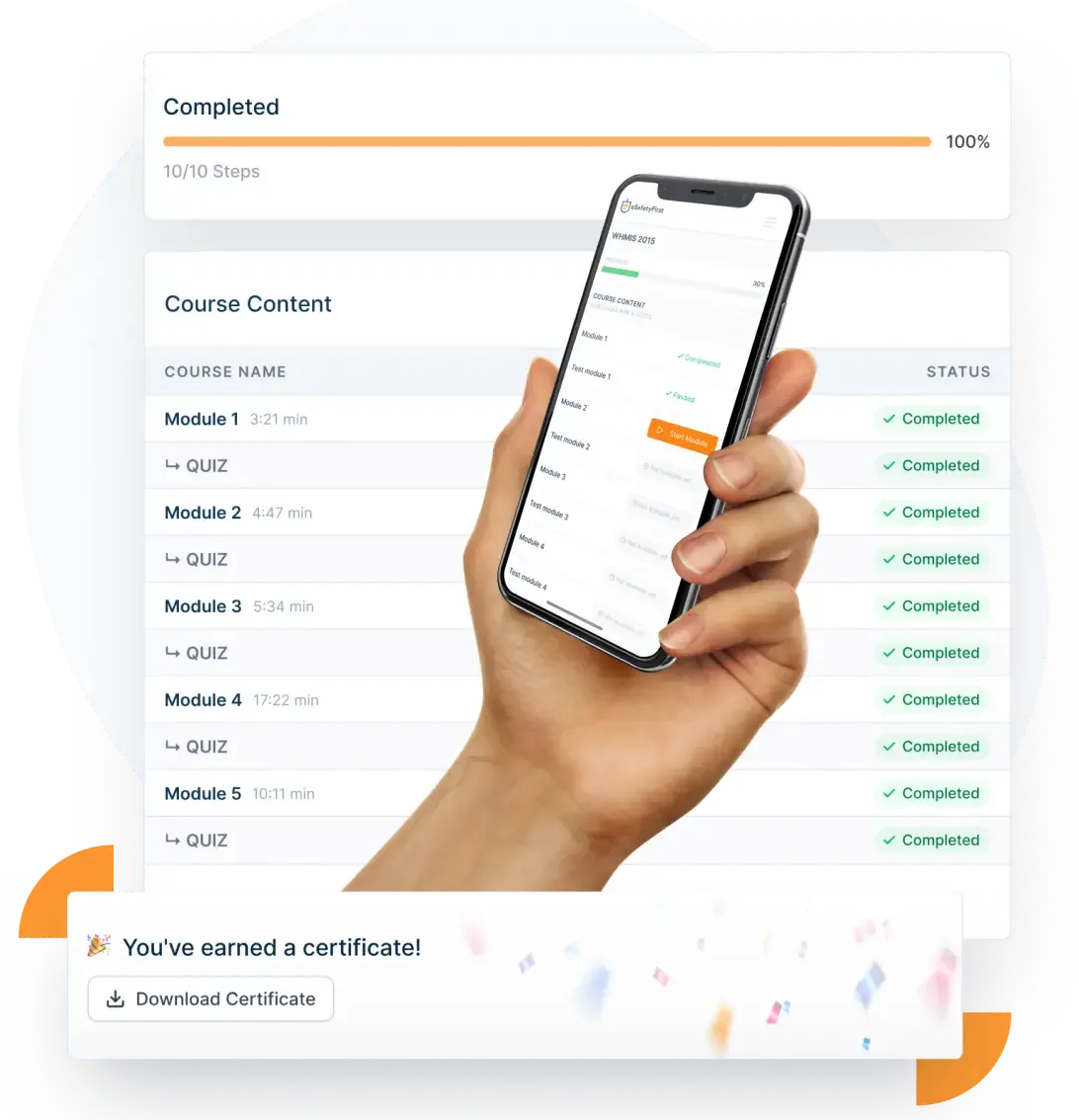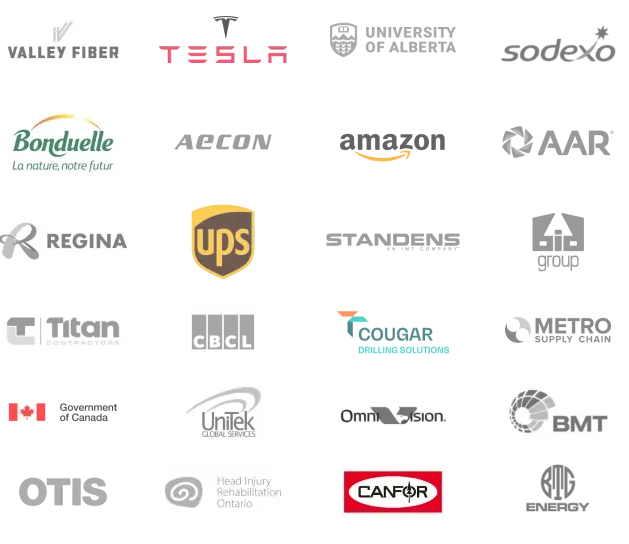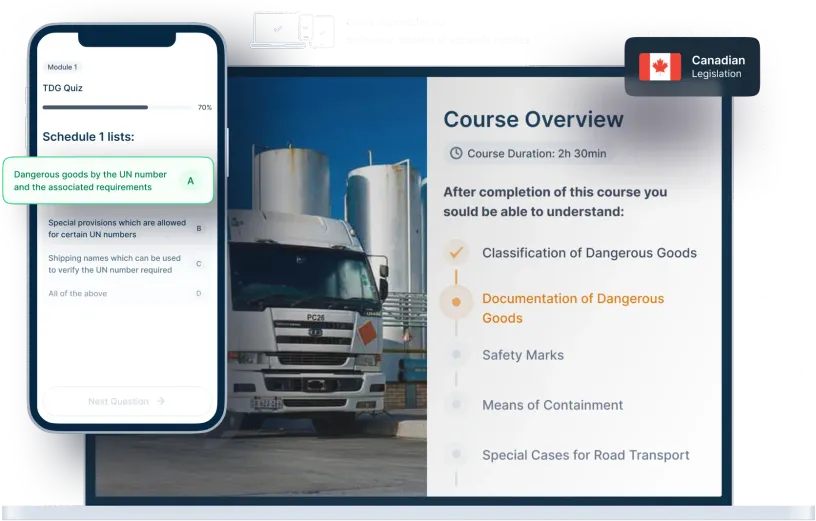Our TDG online training program offers theoretical training and evaluation in compliance with Transport Canada and the OHS Act.
Our easy to use platform allows you to obtain a TDG certificate recognized by employers who strive to meet the demands of the legislation.
- Alberta
- British Columbia
- Manitoba
- New Brunswich
- Yukon
- Nova Scotia
- Ontario
- Prince Edward Island
- Quebec
- Saskatchewan
- Northwest Territories
- Nunavut
- Newfoundland & Labrador
What is TDG
Dangerous goods are items or substances that may pose a risk to human health, property, safety, or the environment during transportation. Such goods must be appropriately labelled, handled, and contained according to regulations to protect public safety.
This comprehensive course in TDG teaches workers how to recognize and correctly communicate the nature and level of danger associated with specific chemicals. In addition, students learn how to transport and contain dangerous goods and how to report their operations properly.
While this is a commercial page where we provide TDG online training courses, we've also created a dedicated page where you can learn more about Transportation of Dangerous Goods.
What you'll learn
TDG Online Training includes 7 modules and 7 tests.
Introduction to TDG
Familiarize yourself with the basics of the Transportation of Dangerous Goods Act and Regulations requirements.
Classification of Dangerous Goods
Learn how dangerous goods are classified under the TDG Act and Regulations, the nine hazard classes and the relationship of TDG classes to shipping requirements and safety marks.
Documentation of Dangerous Goods
Learn about the purpose of documentation, the required information elements for shipping documents and the requirements for consignors, carriers and consignees.
Safety Marks
Learn under what conditions it is necessary to display safety marks on dangerous goods in transport and what those marks are.
Means of Containment
Familiarize yourself with various kinds of means of containment for dangerous goods under the TDG Act and Regulations.
Special Cases for Road Transport
Learn about exemptions or partial exemptions from the requirements in the TDG Act and Regulations.
Emergency Response
Familiarize yourself with the various types of dangerous occurrences and requirements for reporting and responding to leaks and spills under the TDG Act and Regulations.
What you'll get
Purchasing a TDG online training course, comes with the following materials and benefits.
Course Duration
2 h 30 mins
OHS Compliance
Following latest standards and topic requirements imposed.
Course structure
7 modules and 7 tests.
Languages available
English, French.
Course Format
Cross-Device Compatible.
Support
Chat, Email, FAQ & Phone Support available to all customers.
Course Access
Courses available 24/7.
Unlimited exam attempts
Customers don't have to pay again when failing a testing section.
Course Updates
Always updated to the latest legislative changes.
Certificate of Completion
The course includes a digital certificate, issued immediately upon completion.
Are you looking to purchase courses for yourself or to train your staff?
Not tech-savvy? Not a problem.
Our easy-to-use platform allows anyone with an internet connection to access their training material and obtain a TDG certificate.

Complete the training in your own time: no more chasing instructors or scheduling appointments.
Start, pause and resume at your discretion—100% Pass rate with unlimited exam attempts.
Upon completion, you will immediately obtain a digital certificate which you can download and print.
You can make your laminated wallet card or request a hard copy from us for only $10 more.
Don't worry about making any mistakes because the process is this simple.

Over 200,000 Workers Trained
Our online TDG Training Course is perfect for:
- Workers who are starting a new job and need their TDG certification.
- Workers whose current employer has directed them to obtain a TDG certificate.
- Workers who are renewing their current TDG certificate.
- Self-employed workers.
“I found the site easy to navigate and courses nicely outlined and accessible. The cost was very reasonable as well.”
5 Reviewed 5 hours ago
Leon S.
“Fantastic, easy to understand programs, instant results in the workplace, or employment agency. Great price! Beautiful, professional certificate. I highly recommend eSafetyFirst!”
5 Reviewed 5 hours ago
Timothy C.
Over 25,000 organizations are already working with us
Canadian organizations from all industries


Other courses you should take
Those who acquire TDG training also consider courses in:
Frequently Asked Questions
- How can I find my certificate?
In most cases, this question is addressed to us by individuals who took their training with a different company. As a private company, we can only store and access our customers’ data. Therefore, if you did your training with another company, you must contact them to receive a copy of your certificate.
If you are a customer of eSafetyFirst.com, all you have to do is to Login to your account, and you can, at any time, download a copy of the certificate you received from us.

- Do you provide in-person or classroom training?
No.
We currently do not provide such services, and we have no plans to do so. - Are eSafetyFirst courses recognized in the industry?
Trained professionals have developed all our courses following Canadian Safety Standards to provide participants with the necessary knowledge of hazards and safe workplace environments.
These courses are developed to meet and exceed the OHS Standards and the latest CSA Standards. Therefore, they are recognized by OHS and Worker Compensation Boards. - How can I create an account on eSafeteyFirst?
A customer account is created in the checkout process, where you will be asked, among other billing details, for an email & password.
If you purchase our courses for your employees, you do not need to create an account for each.
When a course is purchased, there are two options following the course name:
i) “Start Course”, which will begin the presentation under the name set in the checkout process.
ii) “Train Someone Else”, which in return will ask the user to enter these details: first name, last name and (optionally) email address of the worker who is supposed to be assigned the course.If the customer who paid for the program doesn’t need the training and, respectively, the certificate, the customer would have to click on the “Train someone else” option and complete the required information.
